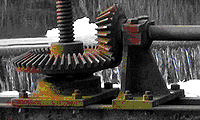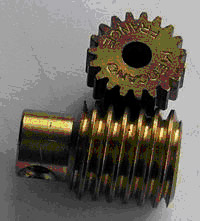Backlash : Backlash is the error in motion that occurs when gears change direction. It exists because there is always some gap between the tailing face of the driving tooth and the leading face of the tooth behind it on the driven gear, and that gap must be closed before force can be transferred in the new direction. The term “backlash” can also be used to refer to the size of the gap, not just the phenomenon it causes; thus, one could speak of a pair of gears as having, for example, “0.1 mm of backlash.”
Bearings : A bearing is a device to permit constrained relative motion between two parts, typically rotation or linear movement. Bearings may be classified broadly according to the motions they allow and according to their principle of operation as well as by the directions of applied loads they can handle.
Bevel gears are essentially conically shaped, although the actual gear does not extend all the way to the vertex (tip) of the cone that bounds it. With two bevel gears in mesh, the vertices of their two cones lie on a single point, and the shaft axes also intersect at that point. The angle between the shafts can be anything except zero or 180 degrees. Bevel gears with equal numbers of teeth and shaft axes at 90 degrees are called miter gears.

Brushless – A brushless DC motor (BLDC) is a synchronous electric motor which is powered by direct-current electricity (DC) and which has an electronically controlled commutation system, instead of a mechanical commutation system based on brushes.
The teeth of a bevel gear may be straight-cut as with spur gears, or they may be cut in a variety of other shapes. ‘Spiral bevel gears‘ have teeth that are both curved along their (the tooth’s) length; and set at an angle, analogously to the way helical gear teeth are set at an angle compared to spur gear teeth. ‘Zerol bevel gears‘ have teeth which are curved along their length, but not angled. Spiral bevel gears have the same advantages and disadvantages relative to their straight-cut cousins as helical gears do to spur gears. Straight bevel gears are generally used only at speeds below 5 m/s (1000 ft/min), or, for small gears, 1000 rpm.
Compound Wound – A combination of the shunt wound and series wound types combines the characteristics of both
Encoder – An encoder is a device used to change a signal (such as a bitstream) or data into a code
Form Wound Coils : Coils wound in form and shaped ready to insert into the slot of a motor.
Frame : The main motor housing. Can be constructed of aluminum, steel, or cast iron.
Hall Effect – experiment that shows the sign of the charge carriers in a conductor.
Gear Class: Gear Class is a measure of several parameters that determine gear quality. In the US, there are AGMA classes ranging from 5 – 20, with classes above 10 generally being hardened and ground. In Europe, the quality specification is DIN, range 1-7.
Helical Gear : Helical gears offer a refinement over spur gears. The leading edges of the teeth are not parallel to the axis of rotation, but are set at an angle. Since the gear is curved, this angling causes the tooth shape to be a segment of a helix. The angled teeth engage more gradually than do spur gear teeth. This causes helical gears to run more smoothly and quietly than spur gears, and to be able to transmit more power.
Inverter duty Motors
Inverter : A term commonly used for an AC adjustable frequency drive. An inverter is also a term used to describe a particular section of an AC drive. This section uses the DC voltage from a previous circuit stage (intermediate DC circuit) to produce an AC current or voltage having the desired frequency
Meg Test – An Electrical test to check stator winding insulation resistance
Pin Out – In electronics, a pinout is a cross-reference between the contacts, or pins, of an electrical connector and their functions.
Poles – Poles are the number of sets of three-way electromagnetic windings that a motor has. In the simplest three-phase motor, there are 3 separate electromagnets formed by the single set of three-way windings. Thus, there is a set of North-South electromagnetic poles formed. This motor is said to have “2 poles” (although strictly speaking, the motor has 6 electromagnetic poles). The next most complex motor has two sets of three phase windings, and is called a “4-pole motor”. It is the most common motor produced, and has a 60 Hertz base speed of 1800 rpm (the 50 Hertz speed is 1500 rpm). 6-pole motors operate at 1200 rpm (1000 rpm at 50 Hertz). 8-pole motors operate at 900 rpm (750 rpm at 50 Hertz).
Pole: A definite group of coils connected in series that will show a uniform polarity with DC current applied. This can also be only one coil. This also applies to AC current rotating equipment.
Planetary Gear Box : Epicyclic gearing or planetary gearing is a gear system that consists of one or more outer gears, or planet gears, revolving about a central, or sun gear. Typically, the planet gears are mounted on a movable arm or carrier which itself may rotate relative to the sun gear. Epicyclic gearing systems may also incorporate the use of an outer ring gear or annulus, which meshes with the planet gears.
Random Wound Coils : Also called mush wound coils — where the turns are wound without definite placement, or, at random
Resolver – (electrical), a type of rotary electrical transformer used for measuring degrees of rotation
Rotor : The rotating member of an induction motor with a shaft. Current is normally induced in the rotor which reacts with the magnetic field produced by the stator to produce torque and rotation.
Shimming : In engineering, a shim is a thin and often tapered or wedged piece of material, used to fill small gaps or spaces between objects. Shims are typically used in order to support, adjust for better fit, or provide a level surface. Shims may also be used as spacers to fill gaps between parts subject to wear and to set clearances for bearings. Spherical Roller Bearing: Spherical Roller Bearings are a type of bearing that uses barrel-shaped spherical rollers.
Stator : That part of an induction motor’s magnetic structure which does not rotate. It usually contains the primary winding
Vertical Turbine pump : A Vertical Turbine Pump is a pump consisting of vertical shaft and multiple impellers and bowls, taking suction from the very bottom of the pump.
Wear Rings : Wear Rings are used in pumps as a replaceable part at the point where the rotating impeller is in very close proximity to the stationary case.
Worm gear : A worm is a gear that resembles a screw. It is a species of helical gear, but its helix angle is usually somewhat large (ie., somewhat close to 90 degrees) and its body is usually fairly long in the axial direction; and it is these attributes which give it its screw like qualities.

A worm is usually meshed with an ordinary looking, disk-shaped gear, which is called the “gear”, the “wheel”, the “worm gear”, or the “worm wheel”. The prime feature of a worm-and-gear set is that it allows the attainment of a high gear ratio with few parts, in a small space. Helical gears are, in practice, limited to gear ratios of 10:1 and under; worm gear sets commonly have gear ratios between 10:1 and 100:1, and occasionally 500:1
Worm gear sets are inherently inefficient because of relative sliding between the gear and the worm. Helical, spur and bevel gear sets, however, operate by rolling off of the mating tooth like a ball bearing.